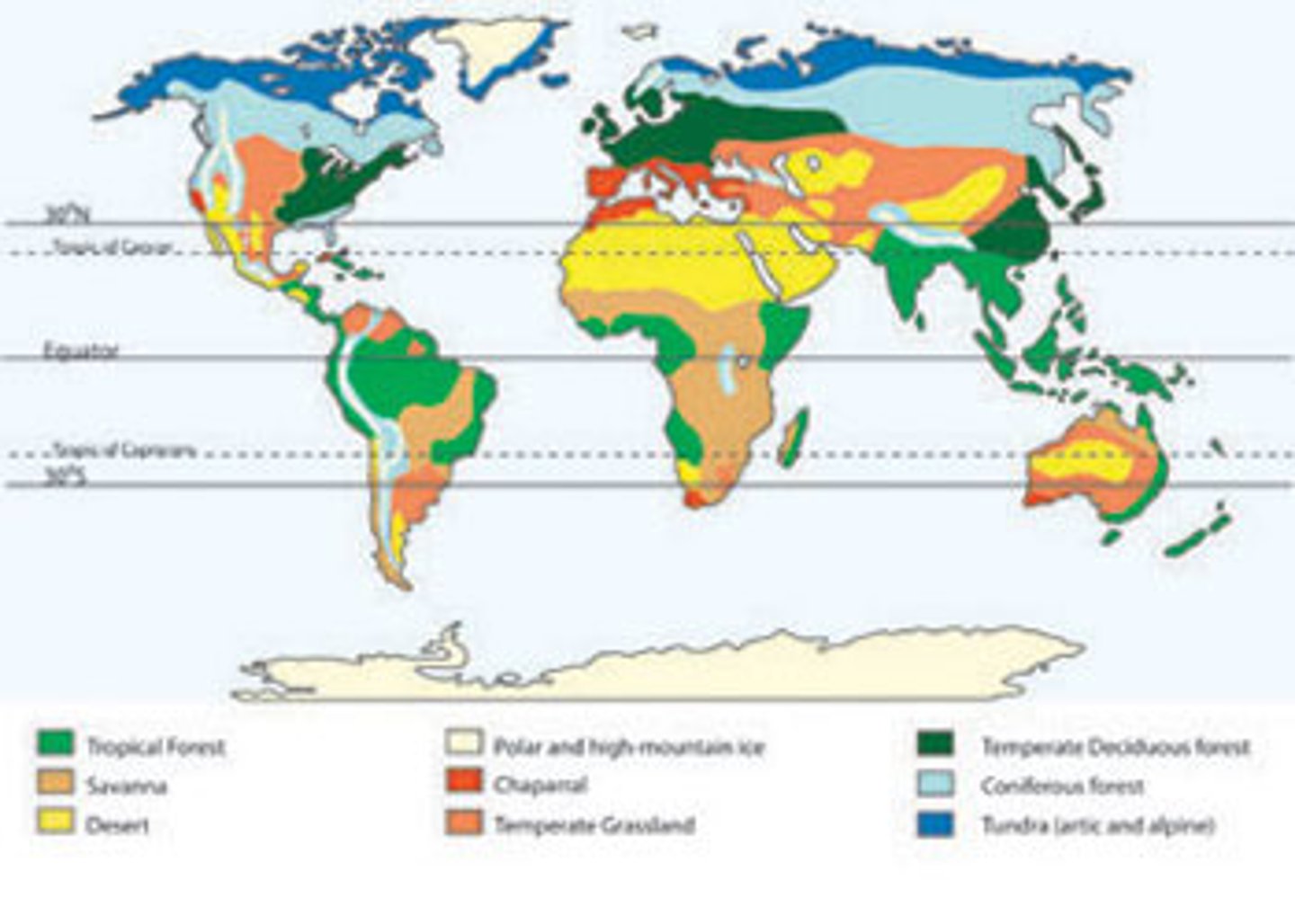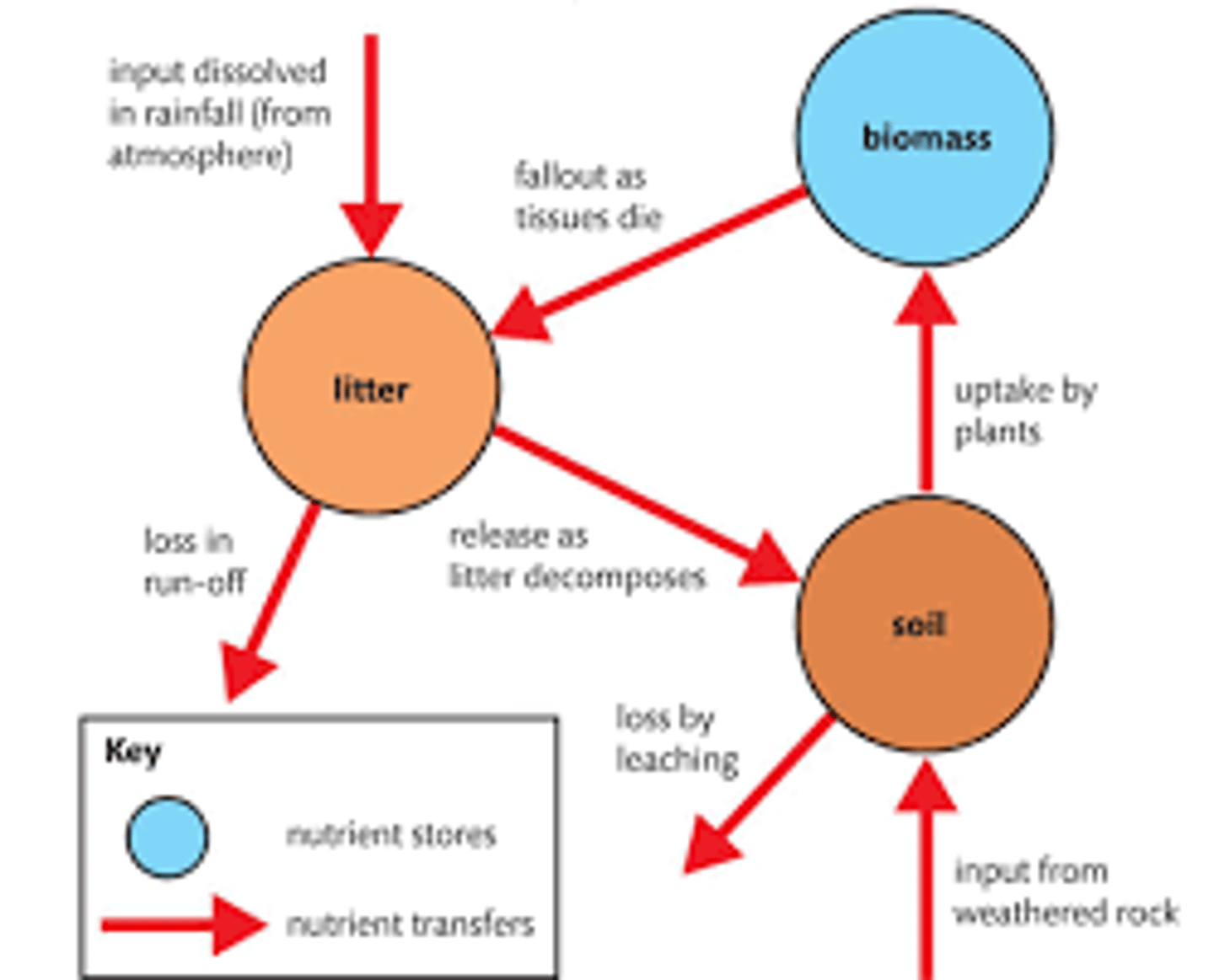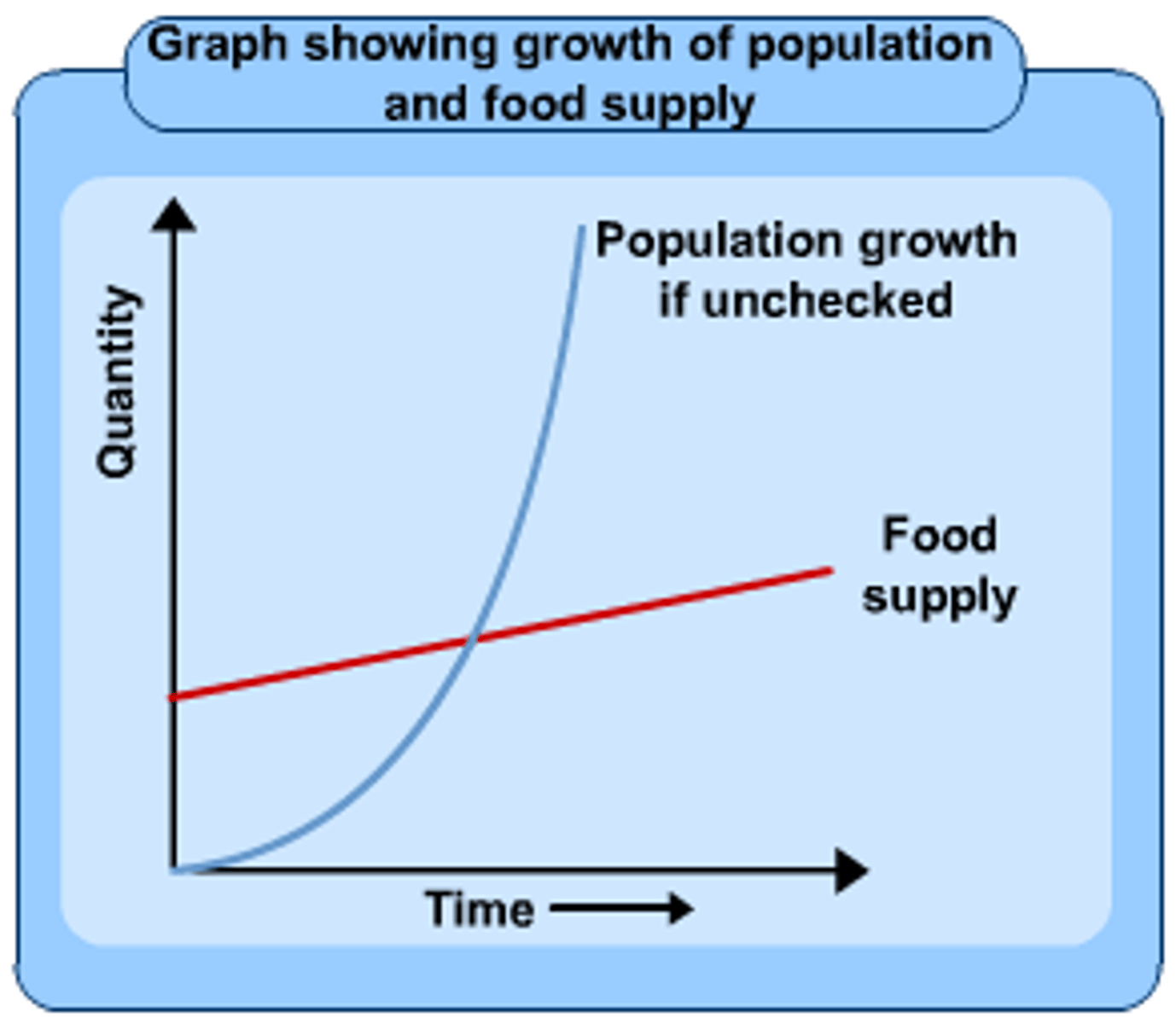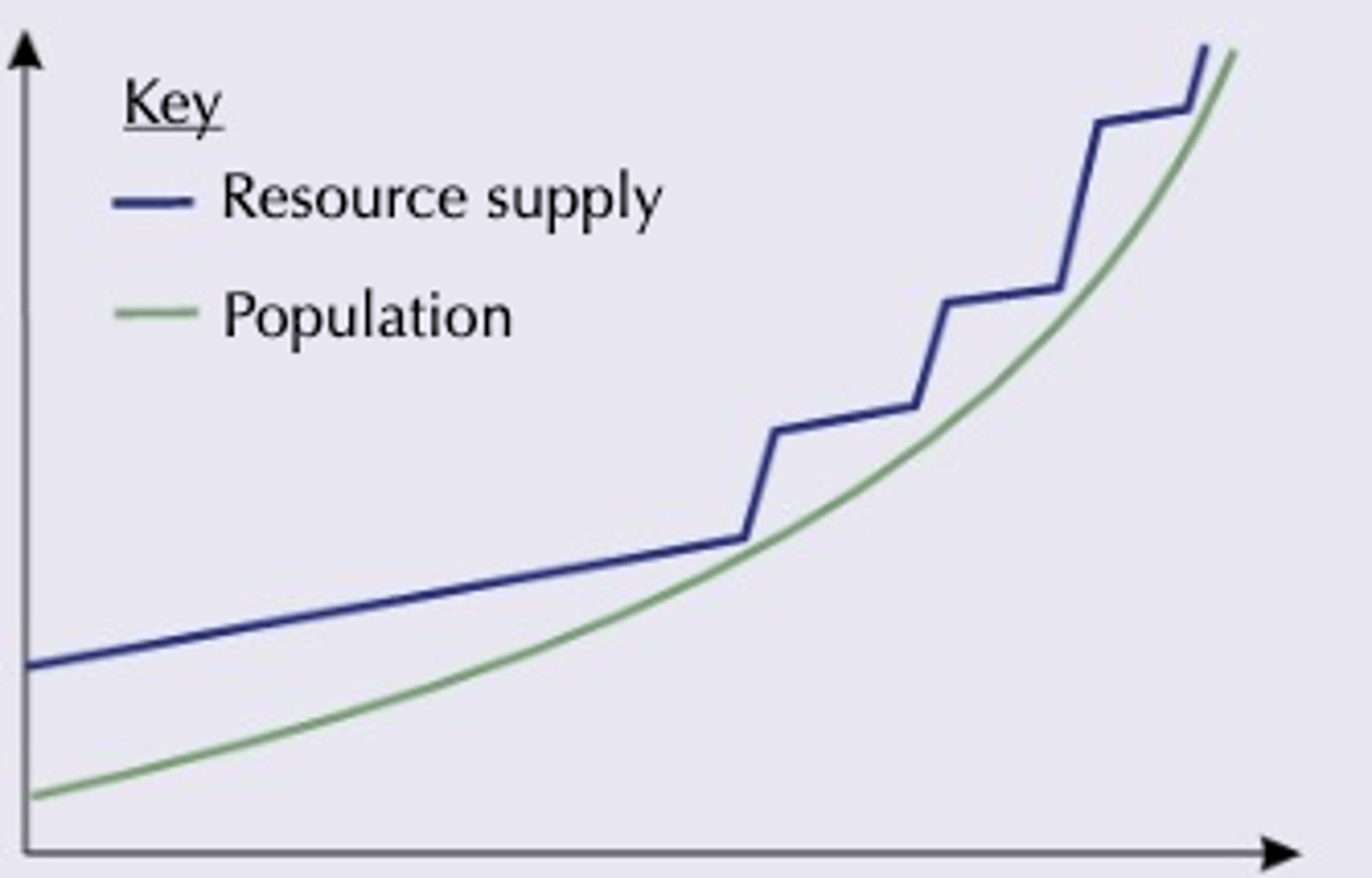Topic 7 - People and the Biosphere
1/47
Earn XP
Name | Mastery | Learn | Test | Matching | Spaced |
|---|
No study sessions yet.
48 Terms
Biosphere
The part of the Earth inhabited by living things
Ecosystem
A biological community of interacting organisms and their local environment.
Biome
A very large scale ecosystem e.g desert, tropical rainforest
Biomass
The mass of living organic matter in a given area of an ecosystem or biome
Distribution of the world's biomes
(in purple book)

Tropical Rain Forest
Latitude:
Regions:
Climate:
Vegetation:
Latitude: Equatorial, mainly 0-15°N/S
Regions: Northern South America, India, SE Asia, all Indonesia
Climate: Hot all year (25-30°C), Wet all year (2000-3000mm)
Vegetation: Dense forests with several layers of trees, infertile due to leaching and rapid uptake of nutrients by plants
Tropical grasslands
Latitude:
Regions:
Climate:
Vegetation:
Latitude: Mainly between tropics 0-25°N/S
Regions: central and Southern Africa, Brazil, Chile, Northern Australia
Climate: Hot all year (25-30°C), moderate precipitation (500-1000mm)
Vegetation: Tall grasses, vegetation adapted to wildfires
Deserts
Latitude:
Regions:
Climate:
Vegetation:
Latitude: Mainly around tropics 15-30°N/S
Regions: North Africa, Middle East, parts of China
Climate: very hot all year (above 30°C), cool nights, very low precipitation (<250 mm)
Vegetation: Low biomass, water store features, extensive roots, spines instead of leaves e.g cacti
Temperate grasslands (prairie and steppe)
Latitude:
Regions:
Climate:
Vegetation:
Latitude: Mainly 20-50°N/S
Regions: Central Asia, areas of central Australia
Climate: Hot in Summer (25°C), very cold in Winter (to -40°C), moderate precipitation (500-900 mm) most in late spring/ winter
Vegetation: short grasses, few trees or bushes
Temperate forest
Latitude:
Regions:
Climate:
Vegetation:
Latitude: Mainly 25-60°N/S
Regions: Eastern USA, Northern Europe, Japan, East China
Climate: warm summers (approx 18°C), cool winters (approx 5°C), precipitation all year round (around 1000mm)
Vegetation: Deciduous trees (leaves fall off in autumn) e.g oak
Taiga (boreal forest)
Latitude:
Regions:
Climate:
Vegetation:
Latitude: Mainly 50-70°N
Regions: South Canada, most of Russia
Climate: mild summers (10-20°C), very cold winters (<0°C), Low precipitation (<500mm) mainly in Summer
Vegetation: Coniferous trees (have needles instead of leaves and are evergreen) e.g spruce, pine
Tundra
Latitude:
Regions:
Climate:
Vegetation:
Latitude: >60°N
Regions: North America, Russia, Iceland
Climate: very cold all year (mostly <0°C), very mild in short summer (10°C), Low precipitation (often <250mm), short daylight hours in winter
Vegetation: very few plants, mostly grasses, lichens and mosses. Trees are rare and stunted
How is the tropical rainforest biome affected by climate?
- high temps (25-30°C year round) sue to it being equatorial
- high temps means rapidly rising air and low pressure so very high precipitation (2000-3000mm
- large umber of sunshine hrs throughout year meaning high rate of photosynthesis and all yr growth
- high temps, rainfall and sunshine hrs through whole yr results in optimum growth so highest biomass
How is the desert biome affected by climate?
- high temps (above 30°C year round) due to being 15-30°N/S of the equator
- since deserts are 15-30°N/S of the equator (tropics), the cooler, drier air formed at equator descends at the tropics resulting in high pressure thus low rainfall
How is the tundra biome affected by climate?
- Low temps all yr round (mostly <0°C) due to being at the Poles
- low temps mean low rainfall as cold air holds little moisture (often<2500mm)
- short daylight hrs, low precipitation and low temps results in very few plants
Local factors affecting biomes
- altitude
- soils
- rock type
- drainage
How does altitude affect biomes?
- temps fall at a rate of between 0.5 and 1°C for every 100m climbed in height up a hill, more wind, higher rainfall
- forest biomes decrease with altitude, becoming stunted and replaced with harder species like grasses
How does rock type affect biomes?
When rocks weather, they release nutrients so the softer they are, the faster they erode so more nutrients are released into the soil impacting what grows there. Harder rocks weather slower e.g granite which limits the nutrients transferred to the soil thus limiting growth.
How do soils affect biomes?
The soil pH (acidity/alkalinity) affects the plant species which will grow there
How does drainage affect biomes?
If rocks are permeable, the surface may become frequently waterlogged because rain can't drain away. Waterlogged soils prevent growth of trees so peat bogs or another marshland may form with only specially adapted plants like bulrushes growing there.
Biotic components
living parts: the flora (plants), fauna (animals), fungi, bacteria and other forms of life
Abiotic components
non-living parts e.g soils, rocks, water, and air. These components interact all the time and their interaction helps keep ecosystems in equilibrium e.g in a nutrient or hydrological (water) cycle
Biodiversity
the variety of biotic components in an ecosystem
Ways in which biotic and abiotic components interact
- Biological weathering
- Photosynthesis and respiration
- Nutrient cycling
- Hydrological cycle regulation
Biological weathering
Bio-physical: When living things break up a rock e.g when tree roots grow into the joints of a rock and break the rock apart
Bio-chemical: sometimes flora and fauna can secrete acids which dissolve a rock. Most plants do this when they decompose, producing humic acid.
Photosynthesis and respiration
- Plants (producers) take up carbon dioxide in the atmosphere during photosynthesis and convert it into energy (glucose). They use energy from the sun to do this. This energy is passed through the food chain into animals (primary consumers) when they eat plants, and then carnivores (secondary consumers) when they eat primary consumers.
- Plants give out oxygen during photosynthesis, which goes into the atmosphere and is taken up by animals. Animals give out carbon dioxide during respiration, which goes into the atmosphere and is taken up by plants.
- When animals and plants die, they are broken down by decomposers. Decomposition releases nutrients into the soil, where they are taken back up by plant roots.
Nutrient Cycling
The nutrient cycle describes how nutrients are transferred around an ecosystem
- Gersmehl's model said that all ecosystems have the 3 same basic compartments: soil, litter, biomass. Each is a store for nutrients.

Hydrological cycle regulation
- Trees intercept and absorb rainfall and slow its passage to the ground, reducing surface run-off, reducing flood risk - and regulating ground and surface water.
- In tropical rainforests, the transpiration by plants returns moisture to the atmosphere during the day and when temps cool in the evening, condensation takes place and there is heavy precipitation.
- In the desert biome, succulent plants like cacti store water slowing its evaporation.
Explain one way in which vegetation helps soil to develop
- Soils depend on plants for nutrients (1), delivered by decomposition of litter (1)
- Plants biologically weather the bedrock (1) creating the fragments/particles which make up soil (1)
Biosphere resources (goods)
Physical materials that can be gained from the biosphere for human use
Biosphere regulating services
The natural functions of the biosphere that maintain physical systems and in doing so provide benefits for humans.
Examples of biosphere resources (goods)
Food: meat, berries, fruits, nuts
Building materials: Timber from trees, animal dung mixed with clay and straw to make bricks, straw for roofing and insulation
Fuel: Animal dung is dried and burnt as fuel, wood from trees
Medicine: periwinkle plant is used to treat leukaemia and Hodgkin's disease, aloe plant has soothing properties and is used in many cosmetics
Examples of biosphere regulating services
Managing water: Trees can prevent flooding by interception and absorption of rainfall, this reduces the amount of surface run-off and lag time.
Atmospheric regulation: The biosphere supports human existence through regulation of CO2 and O2 in the atmosphere mainly through photosynthesis of plants and respiration of all living organisms.
How do biosphere resources and services support human well-being?
Services:
Provisioning - food, fresh water, fuel, medicine
Regulating - climate regulation, water quality, disease regulation
Cultural - leisure and recreation, cultural heritage, education
Supporting - soil formation, nutrient cycling
These services provide security, basic material for good life, good health, freedom of choice/action and good social relations.
Resource use by indigenous people
- small scale resource use
- community based
- focused on basic needs (subsistence lifestyle)
- low and intermediate technology used
- more sustainable
Resource use by commercial exploitation
- large scale resource use e.g water for industry and agriculture
- global- government and TNC involvement
- Focused on export, profit and economic growth e.g sharp decline of orangutans in Malaysia + and Indonesia due to more destruction of habitats for more plantations which produce biofuel palm oil.
- High tech, industrial technology
- greater social and environmental impacts
Resource demand - Population
- population increase from 3 billion to 9 from 1950-2050
- increasing areas of biomes are cleared for settlements, economic activities (farming, mining, manufacturing, logging)
- increased numbers of animals are hunted or their habitats/food sources are destroyed
- rivers, land and the atmosphere are polluted by waste
Resource demand - urbanisation
- urbanisation has increased to 55% leading to greater urban sprawl
- by 2050 it will reach 66%
Resource demand - affluence
- number of middle class people will grow from 1.8 to 4.8 billion by 2030
- average wealth has increased meaning that people have more money to spend on: food, water, energy, homes, consumer goods
Resource demand - industrialisation
- increasing numbers of countries have industrialised
- recent industrial growth has been mainly in Asia - China and India
- industrialisation increases wealth and resource consumption, as well as transport use
Population and resource theory - pessimistic view
Malthusian theory - Thomas Malthus

Population and resource theory - optimistic view
Boserupian theory - Ester Boserup

Describe the Malthusian theory
Malthusian theory is the idea that Earth's population is growing geometrically, but food supply is growing arithmetically, leading to a food shortage. This leads to increase in deaths due to social unrest, fighting, famine and epidemics until the population decreases until numbers are balanced with the resource supply. The population would then increase until another collapse. The point where population exceeds the food supply is called natural check.
Evidence for the Malthusian theory
Malthusians will point to natural checks that have taken place e.g wars, droughts, famine, spread of disease e.g 'bird flu' and ebola
Evidence against the Malthusian theory
New ways of increasing food and resource production have been discovered such as Green Revolution (high yielding crop varieties, irrigation, use of pesticides)
Describe the Boserupian theory
As population size approaches the point where food/ resources run out, human ingenuity will find ways of increasing food/ resource production enough to meet the demand. "Necessity is the mother of invention" Ester Boserup
Evidence for the Boserupian theory
- Population has increased from 1.5b to 8b in the 20th century - has not crashed
- Improvements in farming - Irrigation, high- yielding crop varieties etc
Food distribution improvements - globalisation, containerisation
Evidence against the Boserupian theory
- some parts of the world suffer periodic famine e.g Sahel in Africa